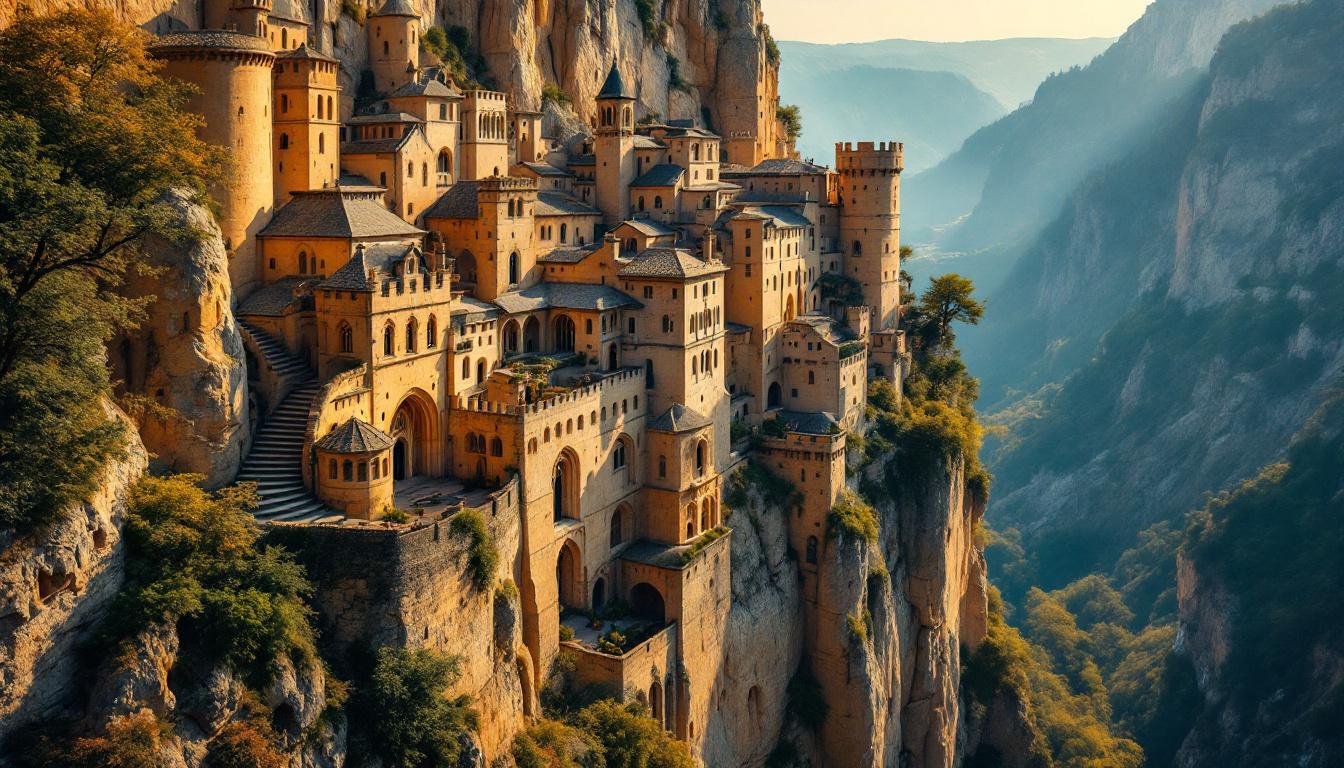Perched 120 meters above the Alzou Canyon, Rocamadour clings to limestone cliffs like a medieval miracle frozen in time. This sacred village of fewer than 2,000 residents welcomes half a million pilgrims annually, yet somehow maintains the intimate spiritual atmosphere that Lourdes lost decades ago to commercial tourism.
While Lourdes transformed into a mass pilgrimage destination after the 1870s railway boom, Rocamadour’s remote cliff-side location protected it from rapid commercialization. The locals still call it “la cité sacrée” – the sacred city – and they’ve spent centuries guarding medieval traditions that disappeared elsewhere when tourism dollars arrived.
Walking these ancient stone paths feels like stepping into the France that existed before gift shops replaced prayer books and tour buses drowned out centuries-old chants. The Vierge Noire statue still draws pilgrims who climb weathered steps on their knees, just as knights did 800 years ago.
The pilgrimage traditions mass tourism couldn’t touch
Sacred rituals preserved by protective locals
In Rocamadour’s Saint-Amadour crypt, pilgrims still venerate the incorruptible saint exactly as medieval devotees did centuries ago. Unlike Lourdes’ commercialized healing baths, access remains controlled by local clergy who prioritize contemplation over crowds. The mysterious black virgin statue can only be touched by ordained priests, maintaining sacred boundaries that commercial sites abandoned long ago.
Medieval architecture untouched by modern expansion
The three-tier sanctuary complex – village, chapel, and castle stacked vertically on cliff face – remains exactly as 12th-century pilgrims experienced it. While Lourdes built multiple basilicas and tourist facilities after 1858, Rocamadour’s UNESCO protection status prevents architectural alterations. Stone steps worn smooth by centuries of faithful feet tell stories no modern construction can replicate.
How Lourdes lost its spiritual intimacy to railway tourism
The commercialization that changed everything
When railways reached Lourdes in the 1870s, the small grotto shrine exploded into mass tourism almost overnight. What began as Bernadette’s quiet visions became a commercial pilgrimage empire complete with souvenir shops, healing water sales, and crowd-management systems. The authentic spiritual experience disappeared beneath layers of tourist infrastructure and profit-driven accessibility.
Rocamadour’s protected remoteness
Rocamadour’s cliff-side isolation saved it from similar fate. No direct railway connection means visitors must make deliberate effort to reach this sacred site. Local communities actively limit large-scale development, prioritizing spiritual preservation over tourist convenience. The result? Authentic medieval pilgrimage experiences that Lourdes can no longer offer.
The authentic spiritual experiences locals still protect
Dawn prayers without tourist crowds
Arrive at sunrise and witness local devotees maintaining 800-year-old prayer traditions in complete silence. The morning light illuminating ancient stone creates the same mystical atmosphere that drew Saint Bernard of Clairvaux and King Louis IX centuries ago. These moments of pure spirituality simply don’t exist in Lourdes’ schedule of organized group activities and commercial tours.
The Via Crucis route unchanged since medieval times
Rocamadour’s stone pilgrimage path follows the exact route medieval faithful carved into cliff face. Each weathered step represents centuries of devotion, unmarked by modern signage or tourist amenities. Walking this ancient way connects pilgrims directly to historical spiritual tradition – something impossible to recreate in Lourdes’ modernized, accessible pathways.
Why August offers the most protected authentic experience
Local festivals prioritizing heritage over tourism
During August’s peak season, Rocamadour’s residents organize traditional festivals emphasizing regional spiritual heritage rather than tourist entertainment. Local clergy restrict sacred space access during prayer times, ensuring authentic devotional experiences remain undisturbed. This protective approach contrasts sharply with Lourdes’ August crowds and commercialized candlelight spectacles.
Sacred silence preserved through controlled access
Rocamadour’s sanctuary maintains contemplative quiet even during busy summer months through careful visitor management. The Saint-Sauveur Basilica limits tourist presence during sacred hours, prioritizing local worshippers over sightseeing schedules. This respectful balance between tourism and authentic spirituality represents everything Lourdes sacrificed for commercial success.
Rocamadour proves medieval pilgrimage traditions can survive modern tourism when communities prioritize spiritual authenticity over profit. These ancient stones hold sacred secrets that commercial destinations lost forever – and locals intend to keep it that way.
Visit respectfully, arrive early, and prepare to experience the France that existed centuries before tourism changed everything. Discover other protected pilgrimage routes maintaining similar authentic traditions, or explore hidden medieval villages where locals still guard cultural heritage. For sustainable travel planning, check our guide to responsible cultural tourism in sacred European destinations.
Planning your authentic Rocamadour pilgrimage
When should I visit Rocamadour for the most authentic experience?
Early morning hours between 6-8 AM offer the most authentic spiritual atmosphere, when local devotees maintain traditional prayer practices without tourist crowds. Late spring (May-June) and early autumn (September-October) provide ideal weather while avoiding peak summer masses.
What medieval traditions can I still witness?
The veneration of the Vierge Noire statue, dawn prayers in Saint-Amadour crypt, and traditional Via Crucis processions along ancient stone paths. Local clergy maintain these 800-year-old practices exactly as medieval pilgrims experienced them, protected from commercial tourism influences.
How is Rocamadour different from Lourdes today?
Rocamadour welcomes 90% French pilgrims seeking authentic spiritual experiences, while Lourdes hosts international mass tourism with commercial healing facilities. Rocamadour’s controlled access preserves medieval atmosphere; Lourdes prioritizes accessibility and tourist services over spiritual intimacy.
Can I participate in traditional pilgrimage practices?
Yes, but with respect for local customs. Climbing stone steps traditionally, attending dawn prayers silently, and following the medieval cliff path are welcomed when done reverently. Unlike commercial pilgrimage sites, authentic participation requires cultural sensitivity and spiritual preparation.
What should I avoid to respect local preservation efforts?
Avoid flash photography in sacred spaces, loud conversations during prayer times, and touching protected artifacts. Locals work hard to maintain spiritual authenticity – supporting their preservation efforts ensures these medieval traditions survive for future generations seeking genuine pilgrimage experiences.
